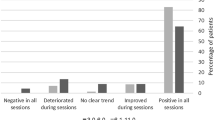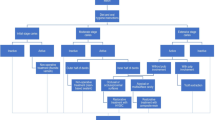Abstract
Aim: To analyse retrospectively the outcomes for children undergoing oral care under conscious sedation with oral midazolam and local analgesia at Leeds Dental Institute, England and Westmead Dental Hospital, Sydney, Australia. Secondly, the study assessed the suitability of oral midazolam for paediatric dental treatment. Study Design: Retrospective study of clinical outcomes based on dental records. Methods: All children included in the study had been treated between September 2000 to August 2004 and full dental records were available. The dental records were examined using a standard pro forma sheet and data collection for: age, previous behaviour using the Frankl [1962] scale, units of work planned and achieved using the modified index of O’Sullivan and Curzon [1991], midazolam dosage and treatment outcome. Results: The study population consisted of 101 children aged 1–11 years in both Leeds (57 children) and Westmead (44 children). There were significant differences between Leeds and Westmead with respect to age (mean ±SD) in years 5.0±1.9 versus 2.9±1.6; number of treatment visits 1.7 versus 1.1; sedation dose used 0.5–0.7 mg/kg versus 0.2–0.3; type and amount of treatment planned 8.3 versus. 3.3 and achieved 7.5 versus 2.2, for both centres respectively. There was also a difference in overall success rates of rendering the children dentally fit of 65% v. 91 %, respectively. Conclusion: Oral midazolam was found to be a useful drug for the management of young children with behaviour problems. It was found, however, not to be effective in all cases and for the provision of all types of paediatric dentistry. The results indicate that, when using oral midazolam in children, treatment should be restricted to simple restorations and extractions over a maximum of two visits.
Similar content being viewed by others
References
AcholLT. Analysis of further dental treatment of children receiving comprehensive dental care under general anaesthetic at Leeds Dental Institute., submitted as partial requirement for a M.Dent.Sci, University of Leeds, 2005
Chief Medical Officer. A Conscious Decision: A review of the use of general anaesthesia and conscious sedation in primary dental care. London, HMSO, 2000
Eidelman E, Faibis S, Peretz B. A comparison of restorations for children with early childhood caries treated under general anaesthesia or conscious sedation. Pediatr Dent 2000;22:33–37. 2000.
Frankl SN, Shiere FR, Fogels HR. Should the parent remain with the child in the dental operatory? J Dent Child 1962;29:150–163.
Fraone G, Wilson S, Casamassimo PS, Weaver II MSJ. The effect of orally administered midazolam on children of three age groups during restorative dental care. Pediatr Dent 1999;21:236–242.
Gallardo F, Cornejo G, Borie R. Oral midazolam as premedication for the apprehensive child before dental treatment. J Clinic Paediatr Dent 1994;18: 123–127.
General Dental Council. Maintaining Standards. Guidance to Dentists on Professional and Personal Conduct. London, 2001
Hennes HM, Wagner V, Bonadio W.A., Glaeser PW, Losek JD, Walsh-Kelly CM, Smith DS. The effect of oral midazolam on anxiety of preschool children during laceration repair. Anns Emerg Med 1990;19:1006–1009.
Hosey MT. Managing anxious children: the use of conscious sedation in paediatric dentistry. Int J Paediatr Dent 2002;12:359–372.
Hulland SA, Freilich MM, Sandor GKB. Nitrous oxide-oxygen or oral midazolam for pediatric outpatient sedation. Oral Surg, Oral Med, Oral Pathol, Oral Radiol, Endod 2002;93:643–646.
Kapur A, Chawla SH, Goyal A, Bhardwaj N. Efficacy and acceptability of oraltransmucosal midazolam as a conscious sedation agent in pre-school children. J Soc Ped Prev Dent 2004;22:109–113.
Lee JY, Vann WF, Roberts MW. A cost analysis of treating pediatric dental patients using general anaesthesia versus conscious sedation. Pediatr Dent 2000;22:27–32.
Marshall WR, Weaver BD, McCutcheon P. A study of the effectiveness of oral midazolam as a dental pre-operative sedation and hypnotic. Special Care Dent 1999;19:259–266.
Matharu LM, Ashley PF. Sedation of anxious children undergoing dental treatment (Review). The Cochrane Database of Systematic Reviews 2005, Issue 2.Art.No.: CD003877. 2005.
Nathan JE, Vargas KG. Oral midazolam with and without meperidine for management of the difficult young pediatric dental patient: a retrospective study. Pediatr Dent 2002:24:129–138.
O’Sullivan EA, Curzon ME. The efficacy of comprehensive dental care for children under general anaesthesia. Brit Dent J 1991:171:56–58.
Parnis SJ, Foate JA, Van der Walt JH. Oral midazolam is an effective premedication for children having day stay anaesthesia. Anaesth Intensive Care 1992:20:9–14.
Roberts GJ. Inhalational sedation (relative analgesia) with oxygen/nitrous oxide gas mixture: principles. Dental Update 1990:17:139–146.
Roberts, G.J, Hosey, M.T. “Pharmacological management of pain and anxiety,” in Paediatric Dentistry, 3rd edn, R. R. Welbury, M. S. Duggal, & M. T. Hosey, eds., Oxford University Press, Oxford, pp. 63–88,2005
Shaw AJ, Meechin JG, Kilpatrick NM, Welbury RP. The use of inhalation sedation and local anaesthesia instead of general anaesthesia for extractions and minor oral surgery in children: a prospective study. Int. J. Paediatr Dent 1996: 6:7–11
SIGN. Safe sedation of children undergoing diagnostic and therapeutic procedures, Scottish Intercollegiate Guidelines Network, Edinburgh, 2005
Standing Dental Advisory Committee. Conscious sedation in the provision of dental care., Department of Health, London, HMSO, 2003
Van der Bijl P, Roelofse JA. Disinhibitory reactions to benzodiazepines: A review. J Oral Maxillofacial Surg 1991:49:519–523. 1991.
Wilson KE, Welbury RR, Girdler NM. A randomised, controlled, crossover trial of oral midazolam and nitrous oxide for paediatric dental sedation. Anaesthesia 2002a:57:860–867.
Wilson KE, Welbury RR, Girdler NM. A study of the effectiveness of oral midazolam sedation for orthodontic extraction of permanent teeth in children: a prospective, randomised, controlled, crossover trial. Brit Dent J 2002b:192: 457–462. 2002b.
Author information
Authors and Affiliations
Corresponding author
Rights and permissions
About this article
Cite this article
Day, P.F., Power, A.M., Bibbert, S.A. et al. Effectiveness of Oral Midazolam for Paediatric Dental Care: A retrospective study in two Specialist Centres. Eur Arch Paediatr Dent 7, 228–235 (2006). https://doi.org/10.1007/BF03262557
Published:
Issue Date:
DOI: https://doi.org/10.1007/BF03262557




